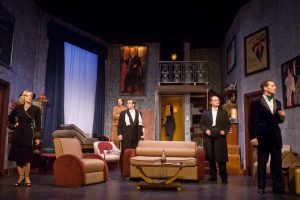
Photo Credit: Roger Mastroianni
On stages in New York, Chicago and Cleveland last spring, more than 750 actors auditioned for just eight open positions in the Master of Fine Arts (MFA) acting program, offered jointly at Case Western Reserve University and the Cleveland Play House (CPH).
Entering its 20th year, the program is not only among the most selective in the country, it’s also one of the most novel. Launched as a revival of a long-dormant partnership between two Cleveland institutions with rich histories in theater, the program is poised for a strong second act—still focused on a single pursuit:
“Shaping the mind, imagination, body and voice of each artist,” Jerrold Scott, professor and chair of the Department of Theater at Case Western Reserve, said, “for a discipline thousands of years old, that still connects people in intimate and commanding ways.
“What an awesome responsibility.”
A teaching hospital for theater
Actors enrolled in the three-year program focus solely on acting—rare for an MFA program—inside a professional regional theater.

Photo by Roger Mastroianni
“It’s the idea of a teaching hospital,” said Ron Wilson, director of the MFA program and resident fight choreographer for CPH. “They’re immersed in the business of theater 24/7, surrounded by professionals and making contacts in the theater world.”
Curriculum traditionally has prepared actors for stage work, with a demanding schedule of classes, rehearsals and performances—held almost entirely at the downtown location of CPH, the first and oldest regional theater in the United States (and celebrating its 100th anniversary season in 2015-2016).
Paired with training in stage combat and Shakespeare are recently-added courses in film, television and voice techniques to “equip actors to develop their craft,” said Scott, “no matter if it’s on stage or in front of a camera.”
In elite company
An entrée into the hyper-competitive world of professional theater acting accompanies the students’ education. Just before graduation, each actor performs a showcase in New York City in front of agents and talent scouts. Most sign with an agent shortly after—a key step in starting their careers.
By then, the students have earned Actors’ Equity Association membership by performing in main stage shows at CPH. These performances, and the prestige of the MFA program, contributed to the theater’s selection for the 2015 Regional Theatre Tony Award.

“When the students are in our plays, they’re ever so much richer,” said Kevin Moore, CPH’s managing director since 2007. “The size and scope of the shows are bigger. Audience members that follow the program see the growth of these fine young actors over time, and feel that they are witnesses to the launch of their careers.”
Upon graduating, the actors join select company: In 20 years, fewer than 70 students have completed the program, including Rich Sommer from TV’s Mad Men, and Elizabeth A. Davis, who garnered a Tony nomination for her Broadway performance in Once.
They also enter the professional ranks with another advantage: “We give students an artistic education—without putting them into debt,” said Wilson of the tuition-free program, which also provides health insurance and a living stipend.
See them on stage
The relationship between CPH and the university—which has one of the oldest academic theater programs in the country—goes back more than 80 years, first teaming up to offer graduate-level training in 1931.
While the collaboration has shape-shifted over the decades, the MFA acting program has developed into a known commodity in theater circles—“perhaps enjoying a higher national profile than local profile,” said Wilson.

“Though I’d be hard-pressed to find another community more supportive of its theater and its young artists,” added Wilson, the Katharine Bakeless Nason Professor of Theater and Drama at Case Western Reserve.
Catch the students on stage this winter in the Case Western Reserve/Cleveland Play House Conservatory Ensemble Series:
- Shakespeare’s The Two Gentlemen of Verona, Feb. 10-13 and 17-20; directed by Paul Mullins.
- Metamorphoses, by Mary Zimmerman, March 16-19 and 23-26; directed by Ron Wilson.
More information—and tickets—is available online.
